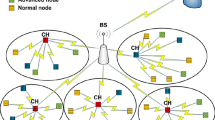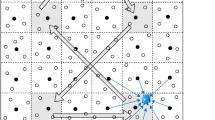Abstract
The wireless sensor networks (WSNs) are a sensing, computing and communication infrastructure that are able to observe and respond to phenomena in the natural environment and in our physical and cyber infrastructure. In order to simulate WSNs, we implemented a simulation system. We implement our system as a multi-model system considering different topologies, radio models, routing protocols and number of nodes. In this work, we consider the goodput, depletion and delay metrics to evaluate the performance of WSNs for AODV and DSR routing protocols considering TwoRayGround and Shadowing radio models, lattice and random topologies, and different number of nodes. We investigate the performance of WSNs for stationary and mobile sink, and stationary and mobile event. The simulation results have shown that for both stationary and mobile sinks, the goodput decreases with the increase of number of sensor nodes. In the case of mobile sink, the goodput is stable and better than in case of stationary sink, especially when the number of nodes is increased. In case of mobile sink, the consumed energy is better than stationary sink (about half of stationary sink). In case of mobile sink, the consumed energy of lattice topology is better than random topology for large number of nodes. In the case of mobile event, the goodput of AODV is better than DSR and it is stable. For large number of nodes, the goodput of DSR is low and unstable. In the case of mobile event, the depletion of Shadowing is lower than TwoRayGround. For low transmission rate, the delay of Shadowing is lower than TwoRayGround. However, for large transmission rate, the delay of Shadowing is higher than TwoRayGround.























Similar content being viewed by others
References
Akan ÖB, Akyildiz IF (2005) Event-to-sink reliable transport in wireless sensor networks. IEEE/ACM Trans Netw (TON) 13(5):1003–1016
Al-Karaki JN, Kamal AE (2004) Routing techniques in wireless sensor networks: a survey. IEEE Wirel Commun 11(6):6–28
Barolli L, Yang T, Kulla E, Sakamoto S, Mino G (2013) Performance comparison of moving sensors and sink with static sink in wsns. In: 16th international conference on network-based information systems (NBiS-2013), pp 194–200
Briscoe G, De Wilde P (2006) Digital ecosystems: evolving service-orientated architectures. In: 1st international conference on bio inspired models of network, information and computing systems, p 17
Carlsen S, Petersen S, Talevski A (2009) Over the horizon intelligent industrial digital ecosystems. In: Proceedings of 3rd international conference on digital ecosystems and technologies, pp 39–44
Castiglione A, Palmieri F, Fiore U, Castiglione A, De Santis A (2014) Modeling energy-efficient secure communications in multi-mode wireless mobile devices. J Comput Syst Sci. doi:10.1016/j.jcss.2014.12.022
Chang E, Quaddus M, Ramaseshan R (2006) The vision of debi institute: digital ecosystems and business intelligence. In: Technical report of DEBII
Chen C-L, Tsai Y-T, Castiglione A, Palmieri F (2013) Using bivariate polynomial to design a dynamic key management scheme for wireless sensor networks. Comput Sci Inf Syst 10(2):589–609
Crossbow (2015) Crossbow Technology Inc. http://www.moog-crossbow.com/
Donward I (2004) Simulating sensor networks in ns-2. Naval Research Laboratory, NRL/FR/552204-10073
Giordano S, Biagioni E (2007) Topics in ad hoc and sensor networks. Commun Mag IEEE 45(4):68–110
Lee J-S, Cheng W-L (2012) Fuzzy-logic-based clustering approach for wireless sensor networks using energy predication. IEEE Sens J 12(9):2891–2897
Perkins CE (2008) Ad hoc networking. Addison-Wesley Professional, Reading
Rappaport TS, Annamalai A, Buehrer R, Tranter WH (2002) Wireless communications: past events and a future perspective. IEEE Commun Mag 40(5):148–161
Wang Q, Barolli L, Kulla E, Mino G, Ikeda M, Takizawa M (2013a) A fuzzy-based simulation system for controlling sensor speed in wireless sensor networks. In: 27th international conference on advanced information networking and applications workshops (WAINA), pp 278–284
Wang Q, Sakamoto S, Barolli L, Kulla E, Mino G, Ikeda M (2013b) A fuzzy-based simulation system for controlling sensor sleep time through lifetime of sensors in wsns. In: Fourth international conference on emerging intelligent data and web technologies (EIDWT-2013), pp 617–623
Werner-Allen G, Lorincz K, Ruiz M, Marcillo O, Johnson J, Lees J, Welsh M (2006) Deploying a wireless sensor network on an active volcano. IEEE Internet Comput 10(2):18–25
Yang T, Barolli L, Iwashige J, Durresi A, Xhafa F (2012) Evaluation of wireless sensor networks for multi mobile events using different topologies, protocols and radio propagation models. In: Computer science and convergence, pp 659–667
Yang T, Ikeda M, Mino G, Barolli L, Durresi A, Xhafa F (2010) Performance evaluation of wireless sensor networks for mobile sink considering consumed energy metric. In: IEEE 24th international conference on advanced information networking and applications workshops (WAINA-2010), pp 245–250
Yang T, Kulla E, Barolli L, Mino G, Takizawa M (2013) Performance comparison of wireless sensor networks for different speeds of multi mobile sensor nodes. In: 27th international conference on advanced information networking and applications workshops (WAINA-2013), pp 371–376
Younis O, Fahmy S (2004) Heed: a hybrid, energy-efficient, distributed clustering approach for ad hoc sensor networks. Mobile Comput IEEE Trans 3(4):366–379
Zhou G, He T, Krishnamurthy S, Stankovic JA (2006) Models and solutions for radio irregularity in wireless sensor networks. ACM Trans Sens Netw (TOSN) 2(2):221–262
Author information
Authors and Affiliations
Corresponding author
Rights and permissions
About this article
Cite this article
Matsuo, K., Elmazi, D., Liu, Y. et al. A multi-modal simulation system for wireless sensor networks: a comparison study considering stationary and mobile sink and event. J Ambient Intell Human Comput 6, 519–529 (2015). https://doi.org/10.1007/s12652-015-0277-8
Received:
Accepted:
Published:
Issue Date:
DOI: https://doi.org/10.1007/s12652-015-0277-8




